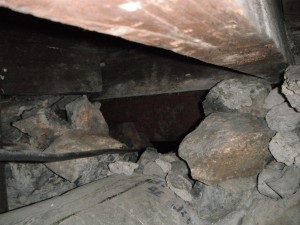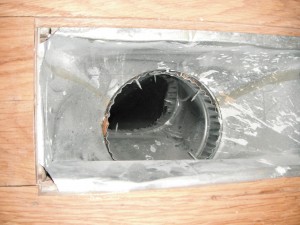All too frequently homes have ridiculously poor workmanship, but homeowners never see it, until they have an audit.
Looking around homes I often see this shoddy work and ask “What is up with that?”, which is then usually repeated by the homeowners when I show it to them.

Hole large enough to fit through.
Frequently we joke about holes large enough to fit through – this one actually is. Okay, maybe it’s big enough for your kid to fit through but it is huge nonetheless.
On May 7, 2011, from 9 am until about 1 pm, we’ll be doing a lot of work we don’t typically do, and leaving to the side much that we would normally focus on, because this “Philadelphia style” two-family home is chock full of “what’s up with that” situations.
We’ll be sealing that hole, many other holes in the basement, sealing a lot of floor registers  that are sending cold basement air, in addition to heated air, through cracks (see right), a bit of ‘stuff/roll/foam’ work in the attic and more.
that are sending cold basement air, in addition to heated air, through cracks (see right), a bit of ‘stuff/roll/foam’ work in the attic and more.
If you can join us, and we hope you can, please let us know by sending an RSVP email to ArlHEET@gmail.com



